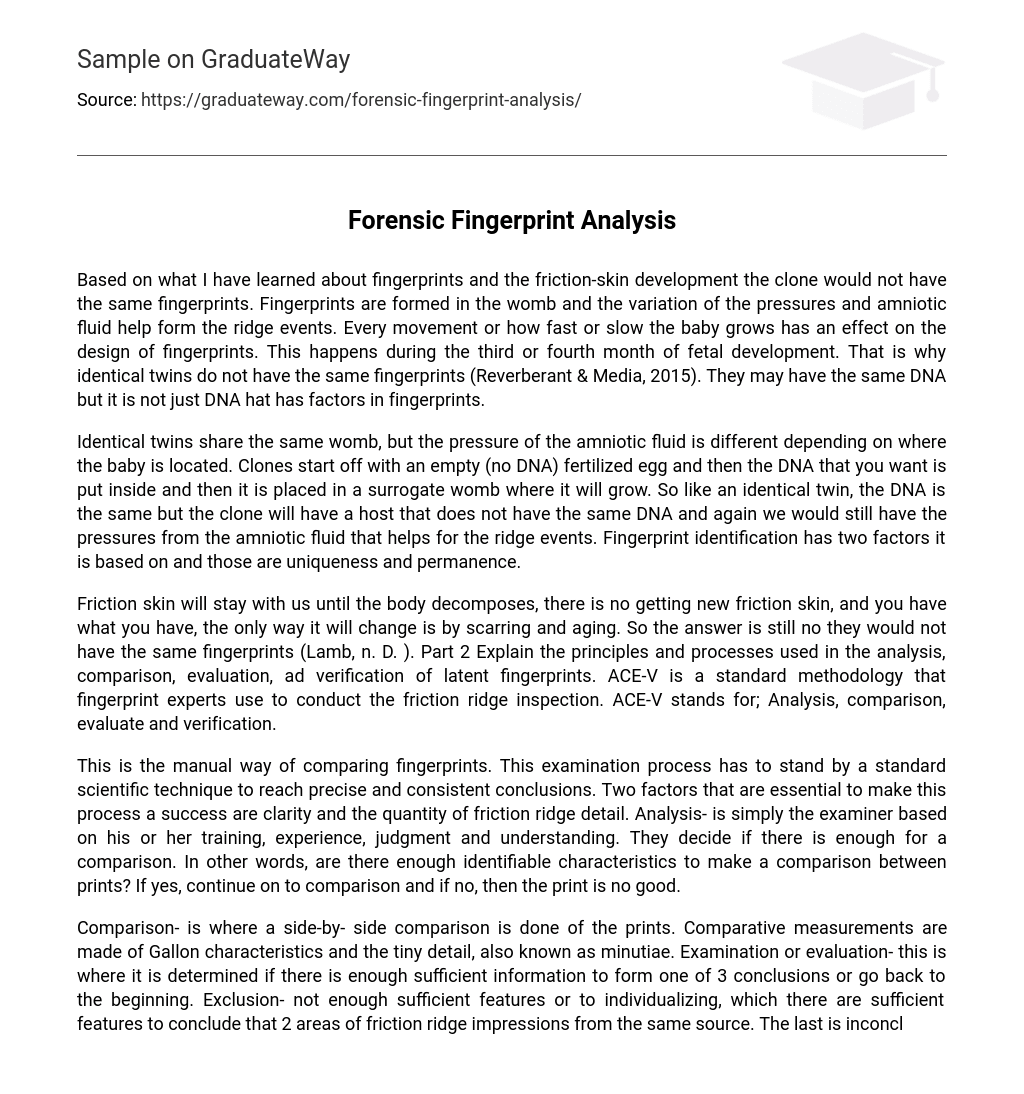Based on what I have learned about fingerprints and the friction-skin development the clone would not have the same fingerprints. Fingerprints are formed in the womb and the variation of the pressures and amniotic fluid help form the ridge events. Every movement or how fast or slow the baby grows has an effect on the design of fingerprints. This happens during the third or fourth month of fetal development. That is why identical twins do not have the same fingerprints (Reverberant & Media, 2015). They may have the same DNA but it is not just DNA hat has factors in fingerprints.
Identical twins share the same womb, but the pressure of the amniotic fluid is different depending on where the baby is located. Clones start off with an empty (no DNA) fertilized egg and then the DNA that you want is put inside and then it is placed in a surrogate womb where it will grow. So like an identical twin, the DNA is the same but the clone will have a host that does not have the same DNA and again we would still have the pressures from the amniotic fluid that helps for the ridge events. Fingerprint identification has two factors it is based on and those are uniqueness and permanence.
Friction skin will stay with us until the body decomposes, there is no getting new friction skin, and you have what you have, the only way it will change is by scarring and aging. So the answer is still no they would not have the same fingerprints (Lamb, n. D. ). Part 2 Explain the principles and processes used in the analysis, comparison, evaluation, ad verification of latent fingerprints. ACE-V is a standard methodology that fingerprint experts use to conduct the friction ridge inspection. ACE-V stands for; Analysis, comparison, evaluate and verification.
This is the manual way of comparing fingerprints. This examination process has to stand by a standard scientific technique to reach precise and consistent conclusions. Two factors that are essential to make this process a success are clarity and the quantity of friction ridge detail. Analysis- is simply the examiner based on his or her training, experience, judgment and understanding. They decide if there is enough for a comparison. In other words, are there enough identifiable characteristics to make a comparison between prints? If yes, continue on to comparison and if no, then the print is no good.
Comparison- is where a side-by- side comparison is done of the prints. Comparative measurements are made of Gallon characteristics and the tiny detail, also known as minutiae. Examination or evaluation- this is where it is determined if there is enough sufficient information to form one of 3 conclusions or go back to the beginning. Exclusion- not enough sufficient features or to individualizing, which there are sufficient features to conclude that 2 areas of friction ridge impressions from the same source. The last is inconclusive- that the examiner is unable to individualize the print.
The final step is verification-the independent application of the ACE process needs o be checked by another examiner without that examiner knowing what the results are. If they both come up with the same conclusion and information it can be verified by the second examiner. Individualizing is the uniqueness and permanence of friction ridges. The ridge impression and the friction skin ridge individualizing results from ACE-V. Part 3 Define class characteristics and individual characteristics of latent fingerprints. Present one example of each and explain how your examples fit the definitions.
Class characteristics are general appearances that define a group of items r objects, but cannot define uniqueness alone or classification by ridge line patterns. There are only three basic patterns and they are loops, arches, and whorls. Loops cover about 60-65 %, whorls cover about 25-30 % and arches cover 5-10% of all fingerprints. These classifications can be divided even further like plain and tented arches, or radial and lunar patterns. An example would be that an examiner found a set of fingerprints on a glass. Now they will be able to compare the prints to see if it has the same print pattern as the offender, which is a loop pattern.
The loop pattern is a fingerprint class type, along with the arch and whorl. Individual characteristics are special appearances that may create the uniqueness of that item or object, like a ridge line, dot or bifurcation. An example of an individual characteristic would the minutiae within the friction ridge, like dots, bifurcation or ridge endings (“Fingerprints,” 2015). So after comparing that the print found on the glass was a loop like the offender and the examiner knows that it is sufficient for comparisons and there are enough identifiable characteristics, it can be compared to the print on file.





